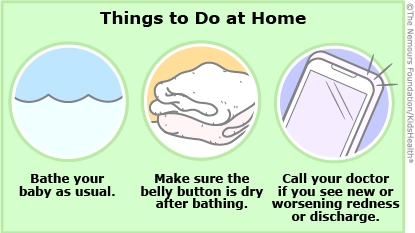Umbilical Granuloma: How to Care for Your Infant
An umbilical granuloma is common in babies; if treatment is needed, the granuloma usually heals without a problem.


The umbilical cord lets blood flow between the mother and baby before the baby is born. At birth the umbilical cord is clamped and cut, leaving a little stump. In the weeks after birth, the stump falls off, leaving the umbilicus (commonly called the belly button or navel).
Sometimes a small lump develops at the bottom of the belly button — this is called an umbilical granuloma. It can be seen once the stump falls off. It is pink and is usually smaller than a peanut (about ¼–½ inch). Sometimes the umbilical granuloma will have a stem or stalk (like a lollipop on a stick) that attaches it to the umbilical stump.
Sometimes an infection happens with an umbilical granuloma and there may be yellow or white drainage from the belly button and sometimes even redness around the belly button. Your child's health care provider will prescribe antibiotics if there is an infection.
Since some umbilical granulomas go away without treatment, your health care provider may suggest that you watch to see if this happens. Sometimes the health care provider uses silver nitrate (a chemical) to dry out the granuloma. A thin wooden stick is used to put the silver nitrate on the umbilical granuloma. It usually dries up and falls off after about two or three treatments. If the umbilical granuloma is large or has a stem or stalk, the health care provider may tie a knot at the bottom of the umbilical granuloma and it will fall off on its own in a few weeks. Since the umbilical granuloma has no nerves, these treatments are not painful to your baby.

-
Give all medications as directed by your health care provider.
-
If your health care provider prescribed antibiotics, be sure to give all of the medicine as directed even if your baby's infection seems to be gone.
-
Follow your health care provider's recommendations to keep the belly button area clean and dry.
-
Schedule all follow-up appointments.

-
The umbilical granuloma has not gone away after following the health care provider's instructions.
-
Your baby is unable to take the medicines that the health care provider prescribed.
-
Your baby seems more sleepy than usual and is not feeding well.
-
Your baby has new or worsening redness or discharge from the belly button.
